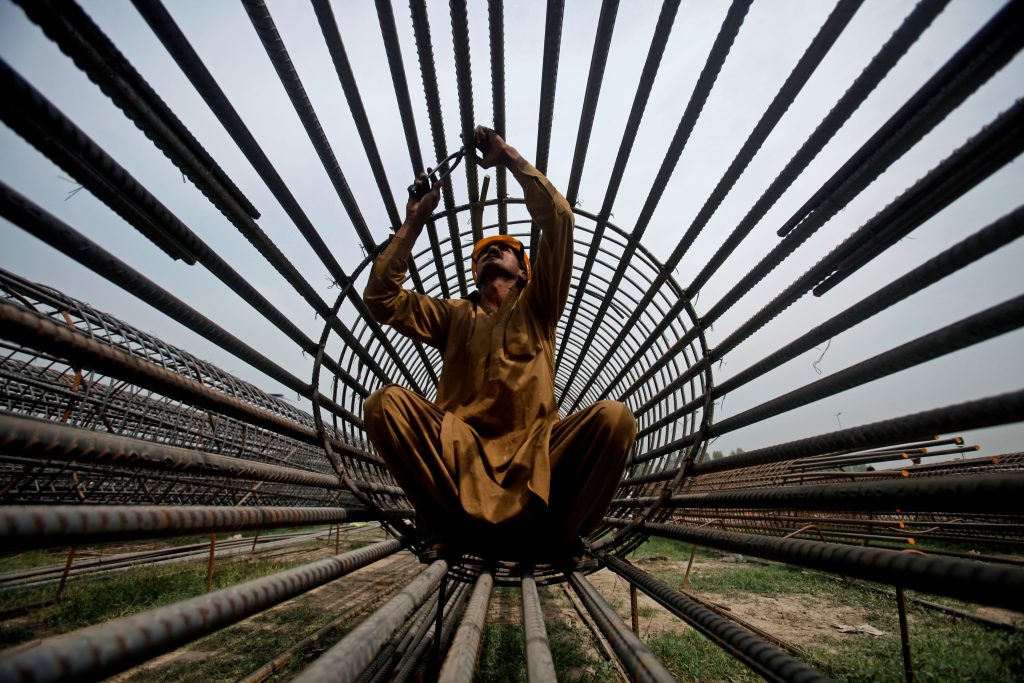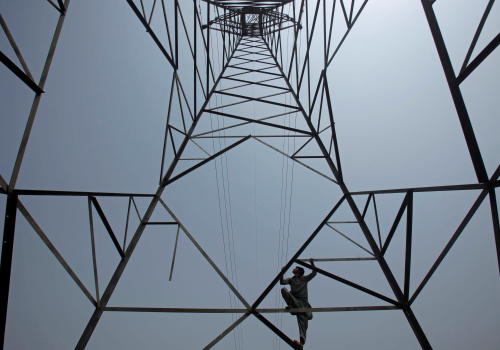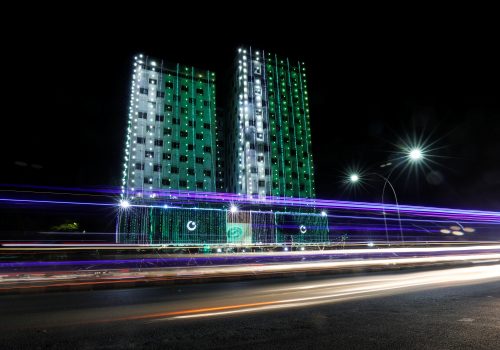Pakistan faces a savings and investment problem. It’s exacerbated by perpetual fiscal deficits that have crowded out the private sector and generated headwinds for productivity growth. Much of the recurring economic crises in Pakistan can be blamed on the inability (and unwillingness) of the government to expand the tax base. As a result, investment in the formal economy as a share of gross domestic product (GDP) is near all-time low levels.
To get out of the current crisis, Pakistan’s policymakers must incentivize the flow of private capital in key sectors of the economy, including infrastructure. Continuing to incentivize informal investments in sectors such as real estate has proven to be a disaster. It is time for Pakistan to create an environment that incentivizes citizens to invest in the country’s long-term development, not just in unproductive and speculative asset classes. This can not only help formalize the economy, but also generate long-term investments critical to sustainable economic and productivity growth.
Pakistan’s untapped informal savings
In Pakistan, investment as a percentage of GDP today stands at only 15.1 percent; the South Asian average is 30.1 percent, while lower-middle-income countries have an investment-to-GDP ratio of 28.5 percent. A significant majority of this investment is driven by public sector expenditure. Recurring economic crises, however, have reduced the government’s ability to fund this investment, primarily because more than 70 percent of available federal fiscal resources are now allocated toward debt servicing; the remainder is mostly utilized to cover the government’s current expenditures.
As a result, Pakistan’s ability to undertake any large-scale infrastructure projects without external borrowing remains severely constrained. Compounding this issue are the disincentives for formal economic activity, which ultimately reduce the capital that can be mobilized across the formal economy, particularly in infrastructure.
It is important to note that a low investment-to-GDP ratio is a function of the low savings rate in the country. Pakistan’s low savings rate is not caused by households’ lack of propensity to save. In fact, this phenomenon exists in Pakistan because most households do not save in the formal financial sector. Given dismal financial inclusion levels, and a rapidly increasing currency in circulation, most savings are in the informal sector, with placements in real estate, gold, livestock, or simply cash stuffed in the mattress. This is a large pool of capital that stays outside the formal financial system, starving it of capital that could be deployed toward more productive uses.
At a time when the capacity of the state to undertake infrastructure projects has been hampered by shrinking fiscal space, there is an opportunity to tap private capital for infrastructure development through multiple structures.
Long-term problems, long-tailed solutions
It is possible to tap this pool of informal capital through long-tailed and project-specific infrastructure bonds. The government already borrows indirectly from the people through treasury bills and bonds, but that is done primarily via banks—and these institutions skim a sweet spread in the middle, not leaving much for the depositor in terms of real savings growth. Furthermore, capital raised in a pooled manner is mostly used to meet current expenditure, often pushing critical infrastructure projects to the back burner.
Policymakers must think creatively to make it possible for the government to directly borrow from the people and households through infrastructure bonds.
By channeling informal capital toward long-tailed infrastructure projects, policymakers can unlock economic growth, improve productivity, and reduce the overall cost of capital in the economy.
One idea is to have a program in which informal capital, or cash, could be used to buy long-tailed infrastructure bonds. These could unlock the capital that exists outside the formal financial system, while raising much-needed funds for infrastructure projects. Incentivizing a transfer of capital from real estate (mostly vacant plots of land) to infrastructure projects through an optimal mix of penalties and incentives will be critical. Pretending that informal capital does not exist outside the system is not going to help the economy. In fact, ignoring this reality has aggravated the investment challenge facing Pakistan’s economy. By channeling informal capital toward long-tailed infrastructure projects, policymakers can unlock economic growth, improve productivity, and reduce the overall cost of capital in the economy.
With such a system in place, citizens could effectively choose which infrastructure projects to support, making the fund allocation and development process more inclusive as well. Capital moving from the informal to the formal sector could be locked in for a predefined number of years, such that the same can be restricted for reallocation into other non-priority areas. Since the infrastructure bonds would be backed by tangible assets, it would also be possible to structure them as Sharia-compliant instruments—a religious and cultural preference for millions of Pakistanis—thereby unlocking a more expansive pool of capital.
There is also an opportunity to attract long-term stable capital for infrastructure projects by tapping pension funds and other holders of long-term capital. The country’s current debt management structure does not inspire confidence, as all capital raised by the state is pooled together and commingled, disincentivizing any fiscal reforms. By ring-fencing infrastructure projects and enabling more public-private partnership structures, it would be possible to attract long-term debt flows into the country through infrastructure bonds or other similar instruments. Providing a tax exemption on interest earned on such instruments could also act as a sweetener to improve after-tax yields on such instruments, making it more market competitive, even after adjusting for political and exchange rate risk.
Across the border, India has recently announced an exemption on taxes for any income or capital gains earned by Canadian pension funds investing in infrastructure projects, paving the way for greater long-term investments in the economy. This demonstrates a departure from an infrastructure program funded by the budget to a private-public partnership regime, where investors with a long-term horizon and higher risk appetite can participate in infrastructure development. There is no reason why Pakistan cannot follow a similar strategy to meet its growing infrastructure needs, especially at a time when the climate disaster is severely impacting the country.
Pakistan should make policy changes to attract long-tailed funds from pension and sovereign wealth funds looking for a higher yield. These funds also have a longer-term outlook and a relatively higher risk appetite. Distinguishing these from conventional sovereign debt can enable the creation of better governance structures for infrastructure projects that can de-risk overall projects relative to the risk of the state. In an environment where the government is already stretched for liquidity, a public-private partnership structure that raises debt independently of the state, and on the basis of respective project cash flows can provide the necessary fiscal impetus required to build infrastructure, while also generating jobs amid a severe economic crisis.
In a typical environment, a fiscal stimulus would have resulted in the creation of jobs and triggered an economic multiplier. However, given recurring deficits and historically high interest rates, the government must utilize unconventional tools to mobilize local private capital and reallocate it toward infrastructure development. Similarly, encouraging public-private partnerships and creating governance structures that align with the requirements of long-term patient capital, whether in the form of pension funds or sovereign wealth funds, is also possible through tax breaks and other incentives.
Pakistan has a fast-growing population base with a high proportion of youth, relatively low participation in the global trade value chain, and a sporadically developed infrastructure and industrial base. The capital required to trigger investment in infrastructure exists in Pakistan, and it can be redeployed to catalyze an economic multiplier, if policymakers seize this opportunity.
Ammar Habib Khan is a nonresident senior fellow at the Atlantic Council’s South Asia Center as well as the chief executive officer at CreditBook Financial Services, which is the financial services arm of the fintech company CreditBook.
Further reading
Mon, Oct 3, 2022
Pakistan sees growing culture of innovation amid tech startup boom
Report By
A tightening global macro environment coupled with increasing domestic political instability is a cause of concern for the sector, especially the domestic startup economy.
Mon, Mar 28, 2022
Pakistan: The next great infrastructure connector
Issue Brief By
Pakistan sits at the crossroads of the abundant resources of Central Asia and the Middle East, and the lucrative markets of China and India. It therefore has the potential to play a significant connecting role, one that enables broader regional interdependency while boosting domestic economic prospects.
Wed, Jul 26, 2023
Pakistan needs to press pause on its data overhaul
New Atlanticist By Uzair Younus
Islamabad appears poised to push through onerous data regulations that will put the country's tech industry under strain—and raise concerns for consumers.
Image: A worker ties steel bars at a construction site for a road in Peshawar, Pakistan March 27, 2018. REUTERS/Fayaz Aziz



